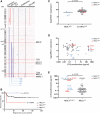Recurrent NR3C1 Aberrations at First Diagnosis Relate to Steroid Resistance in Pediatric T-Cell Acute Lymphoblastic Leukemia Patients
- PMID: 33364552
- PMCID: PMC7755520
- DOI: 10.1097/HS9.0000000000000513
Recurrent NR3C1 Aberrations at First Diagnosis Relate to Steroid Resistance in Pediatric T-Cell Acute Lymphoblastic Leukemia Patients
Abstract
The glucocorticoid receptor NR3C1 is essential for steroid-induced apoptosis, and deletions of this gene have been recurrently identified at disease relapse for acute lymphoblastic leukemia (ALL) patients. Here, we demonstrate that recurrent NR3C1 inactivating aberrations-including deletions, missense, and nonsense mutations-are identified in 7% of pediatric T-cell ALL patients at diagnosis. These aberrations are frequently present in early thymic progenitor-ALL patients and relate to steroid resistance. Functional modeling of NR3C1 aberrations in pre-B ALL and T-cell ALL cell lines demonstrate that aberrations decreasing NR3C1 expression are important contributors to steroid resistance at disease diagnosis. Relative NR3C1 messenger RNA expression in primary diagnostic patient samples, however, does not correlate with steroid response.
Copyright © 2020 the Author(s). Published by Wolters Kluwer Health, Inc. on behalf of the European Hematology Association.
Conflict of interest statement
The authors declare no competing interest.
Figures




References
-
- Riehm H, Reiter A, Schrappe M, et al. [Corticosteroid-dependent reduction of leukocyte count in blood as a prognostic factor in acute lymphoblastic leukemia in childhood (therapy study ALL-BFM 83)]. Klin Padiatr. 1987; 199:151–160. - PubMed
-
- Griffin TC, Shuster JJ, Buchanan GR, et al. Slow disappearance of peripheral blood blasts is an adverse prognostic factor in childhood T cell acute lymphoblastic leukemia: a Pediatric Oncology Group study. Leukemia. 2000; 14:792–795. - PubMed
LinkOut - more resources
Full Text Sources
